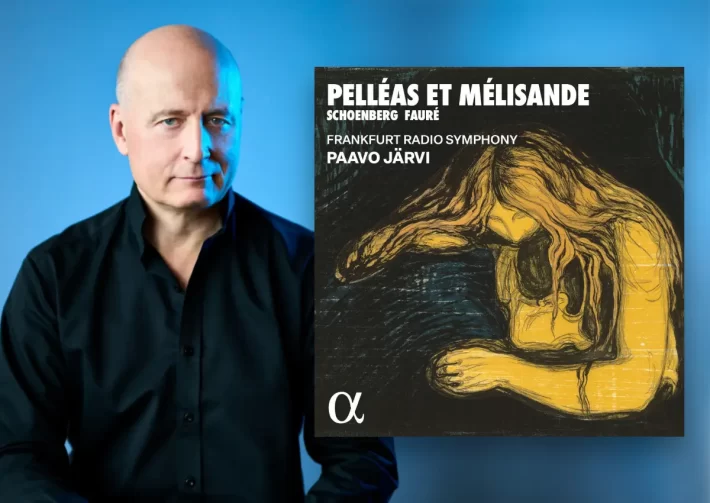Paavo Järvi’s discography includes a substantial portion of Romantic repertoire, including a recently completed cycle of Tchaikovsky symphonies. I have reviewed several of those releases over the years, and have found myself occasionally wondering if there might be even more emotional depth to be unearthed in these familiar works. So, I approached this new recording of Schoenberg’s Pelléas et Mélisande with trepidation, because the tone poem, written in 1902-03, is a veritable hothouse of emotional extremes. But emotional engagement was apparent right from the opening bars, and my concerns quickly dissipated as I fell under the music’s spell.
The work, in one continuous movement, is comprised of eleven interrelated sections (denoted by tempo markings). The huge orchestra offers up a riot of color and volume, and Schoenberg uses a complex leitmotif system to distill the five-act play to its essence by focusing on the characters Golo, Melisande, and Pelleas. The music is sprawling, densely contrapuntal, and intensely operatic.
Järvi has the full measure of the score. As expected, he ensures clarity even in the densest polyphony and elicits an astonishing range of color and dynamics from his Frankfurt players. At just under 41 minutes, his pacing feels exactly right, never wallowing in the sheer beauty of sound as sometimes happens in the recordings by Karajan and especially Thielemann (both in DG), though the opulent tonal sophistication of the Frankfurt orchestra surely warrants it. But what impresses even more is the reading’s dramatic urgency, vividly chronicling the burgeoning love between Pelleas and Melisande and Golo’s jealous rage that leads to the tragic deaths of his brother and wife. This is expressionist storytelling and Järvi lets us hear both its beauty and horror.
The Frankfurt RSO covers itself in glory. Climaxes have tremendous weight and power, but one is equally thrilled by the moments when the players whittle their sound to the most fragile of pianissimos. They cannot have played this music as often as they do a Brahms symphony, and yet they seem completely at home, Moreover, in both solo and tutti playing they are fully invested in conveying both the pictorial and emotional elements of the story. Time and again, the intensity of their playing reminded me of the classic Barbirolli/Philharmonia recording (Warner Classics), though of course, the sound of this new performance is far superior.
Join The Classical Newsletter
Get weekly updates from The Classic Review delivered straight to your inbox.
In 1898 Gabriel Fauré wrote incidental music for a London performance of the same Maeterlinck’s play, reusing some older material as well as writing some new music. He also solicited the help of his pupil Charles Koechlin in orchestrating the music. He later created a four-movement suite, re-orchestrating his student’s work. If Schoenberg paints on a room-sized canvas using bold strokes and oil paints, Fauré works with a smaller canvas and a limited palette of watercolors and delicate brush strokes.
The Fauré performance is just as successful as the Schoenberg. All credit to the Frankfurt orchestra for finding an authentic, more delicate Gallic sound. The playing may have less weight, but the opening of the Prélude conjures an ominous atmosphere, while its central climax has plenty of sensual heat. Mélisande’s Spinning Song follows, played with a graceful delicateness, followed by a sweetly enthusiastic reading of the Sicilienne that never becomes saccharine. Wind solos are gorgeous and supple, most especially the oboe and flute.
The Schoenberg was recorded at the Alte Oper Frankfurt in 2012, the Fauré two years later at hr-Sendesaal Frankfurt. Why have these performances not been issued until now? Perhaps they hoped to record Sibelius’s Pelleas Suite (Järvi recorded the suite with the Estonian NSO in 2001 for Erato.) With these two works, the recording is only 58 minutes, though timing matters less in the face of such excellent performances. The liner notes are brief but informative and the engineering captures Schoenberg’s massive complexity and Fauré’s more intimate impressions well – warmly recommended.
Image © Kaupo Kikkas

Recommended Comparisons
Karajan | Thielemann | Mehta | Stenz
Schoenberg – Pelleas Und Melisande, Op.5
Fauré – Pelléas Et Mélisande, Op.80
Frankfurt Radio Symphony Orchestra
Paavo Järvi – Conductor

Check offers of this album on Amazon Music.
Album Details |
|
|---|---|
| Album name | Schoenberg & Fauré: Pelléas et Mélisande |
| Label | Alpha Classics / Outhere |
| Catalogue No. | 1058 |
| Amazon Music link | Stream here |
| Apple Music link | Stream here |

















